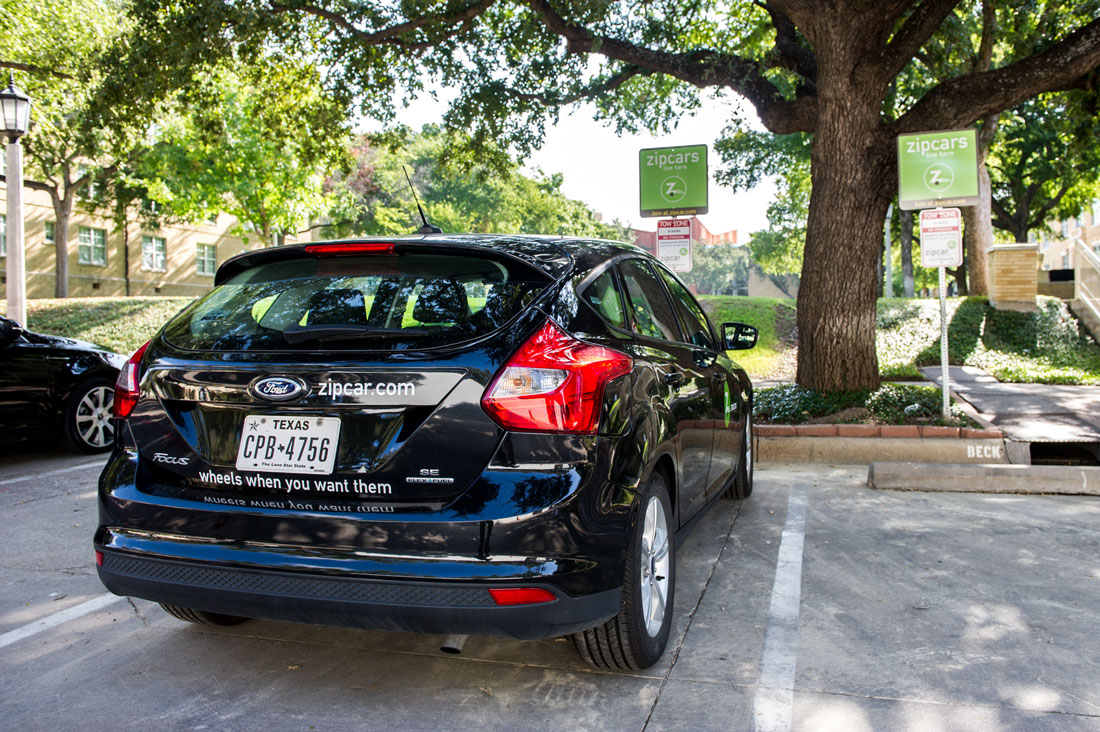When Texas Christian University sophomore Kirina Awamoto moved to Fort Worth two years ago, she made the tough choice to leave her car in California. With insurance, parking, maintenance, and gas, the costs would have been too much, she said. She quickly figured out, though, that she still needed wheels for things like grocery shopping. When she found there was a service called Zipcar that would allow her to rent a car by the hour, she became a regular customer. She now uses the service at least twice a week.
Without it, “I wouldn’t be able to leave campus and run my necessary errands,” Awamoto said.
Zipcar, one of several ridesharing arrangements that have recently begun operating in Fort Worth, works through a phone app. The program launched in Fort Worth in 2012 and caters mainly to TCU students and faculty. Two Zipcar sedans are placed in designated parking spots on campus and can be accessed with a keyless entry card once they have been reserved online. The vehicles can be used for any length of time for a flat hourly rate, but users must return the cars to a designated spot to make them available to others.
With the average cost of car ownership topping $9,000 a year, and with traffic congestion and air pollution high on the list of urban problems, the time is right for ridesharing technologies, said Greg Griffin, associate researcher for the Texas A&M Transportation Institute.
Prices of the services vary widely. Some connect commuters for carpooling, with costs ranging from nothing to a few dollars per trip. Others provide rental cars for short rides across town, similar to Fort Worth Bike Sharing, for a flat fee. Newcomer firms Uber and Lyft, which use phone apps to connect users to a network of drivers for hire, sometimes cost more than a cab. But as a whole, ridesharing services are almost always cheaper than maintaining and operating privately owned cars, Griffin said.
“We’re just at the beginning of this curve,” he said. “Because ridesharing is more reliant on software and information technology than on infrastructure, these technologies are evolving rapidly. One barrier to ridesharing is the convenience of car ownership. Even if it makes sense for someone to use one of these programs, it takes time for people to realize they may not need their car.”
Griffin said that two programs, Car2Go and Carma, are starting to make measurable changes to traffic congestion and air quality in cities like Austin. His group is collecting data on the subject and plans to publish the findings soon.
The ridesharing trend isn’t without its problems. Uber and Lyft do not require all their drivers to carry commercial liability insurance or even to have a commercial driver’s license.
Fort Worth ground transportation coordinator Gerald Taylor said that insurance is at the top of a list of concerns city officials have with Uber and Lyft. He said his department is currently drafting an ordinance that will be sent to the city council for consideration later this year to address that and other issues.
“A lot of individuals [with Uber] use private insurance right now,” he said. “We want them covered commercially while en route. We also want to see some type of documentation regarding drug testing and criminal background checks for these drivers.”
White Settlement resident Michael Bond said his recent experience with San Francisco-based Uber left a good impression. With his car in the shop, a friend gave him a ride to their favorite place to play pool. When Bond found out his friend couldn’t take him home afterward, he considered calling a cab, something he loathes.
“Cabs are always dirty,” he said. “It always looks like the drivers live in there.”
Bond’s friend pulled out his phone, made a few swipes, and said that a ride was on its way. Uber takes 20 percent of the fee, giving the rest to the drivers, who make about $20 an hour.
As the app detailed the location and type of car Uber was sending, the two stepped inside for one last game. A few minutes later, a sleek black Cadillac SUV pulled up.
The car was spotless, Bond recalled. The driver, who works full time for Uber, was professional and the service excellent.
“The driver helped me with my wheelchair,” Bond said.
On the way back, “I asked him if he was insured,” Bond said. He wondered who would be liable for medical bills if there was an accident and he was hurt. The driver dodged the question.
“I thought that part was shady,” Bond recalled. Despite that, he rates the service as top-notch.
One innovative, and potentially risky, approach to ridesharing being developed by companies like Carma and Spedsta uses smartphone apps to connect riders to drivers who are already taking a similar route. Unlike Uber, these companies encourage drivers to provide their services for little or no reimbursement; the company takes 20 percent of any rider donations.
So what motivates drivers to donate their time to help strangers?
Harsh Wanigaratne, vice president for Spedsta, based in San Diego, said many drivers like having someone to talk to and helping the environment while also possibly making a few bucks. Taking part in the service doesn’t add much time to a driver’s trip, he said, because the program matches riders to the route the driver is already taking.
For many women, who make up 40 percent of Spedsta users, the idea of being picked up by a male stranger is potentially risky. Wanigaratne said his company has two safety programs in place that address those concerns.
“We encourage all riders to rate their drivers afterward,” making public any inappropriate behavior, he said. Riders can also use a phone app to let their friends track their location in real time.
Griffin said the Transportation Institute hasn’t found any studies on crime connected to ridesharing, but his guess is that it does keep some people from using such services.
The institute is studying a technology similar to Spedsta, used by the Ireland-based company Carma.
“There’s an option [for Carma users] to give people rides for free, or the driver can request a 20-cent-per-mile fee, but it’s not something where a driver can make money,” he said. “It would make sense if you were giving someone a ride on a route that you were already taking.”
Kathy Cavins-Tull, TCU vice chancellor for student affairs, said the Zipcar program, initiated by the student government association, is here to stay.
“The Zipcar program gives students who don’t have access to a car the freedom and flexibility to attend job interviews and participate in off-campus activities,” she said. “It also provides a way for students to … reduce their environmental impact.”
Zipcar spokesperson CJ Himberg said the company provides liability insurance for users. Her company plans to expand into Dallas this fall.
Dallas City Council member Sandy Greyson is directing efforts to overhaul that city’s transportation ordinances to cover companies like Uber and Lyft, which began operations in Dallas two years ago. She and her colleagues are working with Fort Worth officials to create a uniform approach that addresses things like insurance and criminal background checks on drivers.
However, her approach differs from the single-purpose ordinance that Fort Worth staffers are working on. Greyson wants to overhaul all of Dallas’ transportation regulations to cover many different transit options that may be coming.
With all the rapid changes in how people travel in North Texas, Greyson said, public officials need to be open-minded and farsighted in their approach.
“We don’t want to have to draft a new ordinance every time something new comes out,” she said.
Edward Brown can be reached at ejb0017@yahoo.com.












